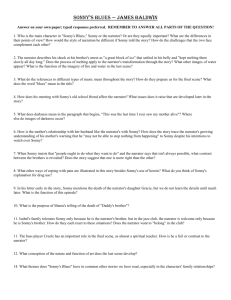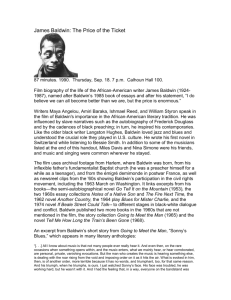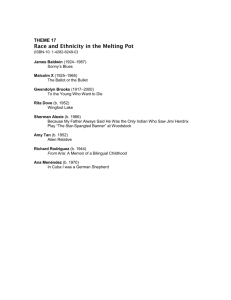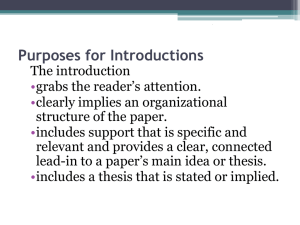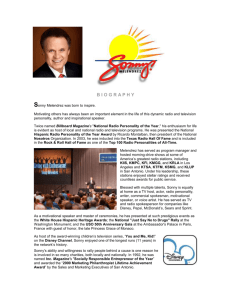James Baldwin's Blues and the Function of Art
advertisement
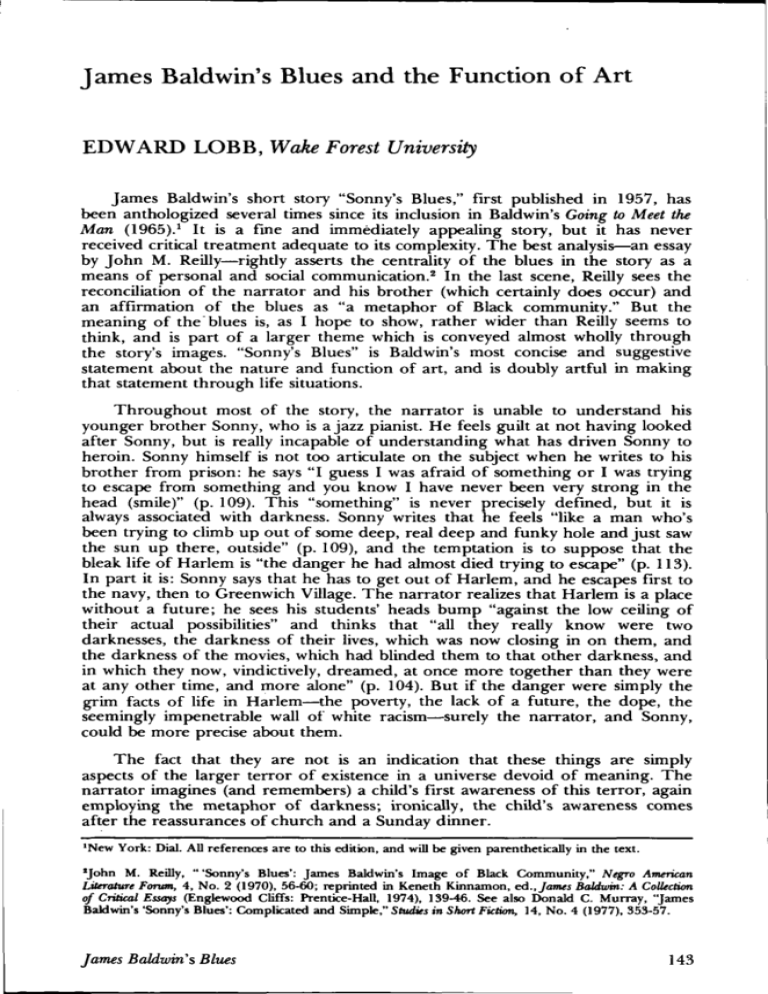
James Baldwin's Blues and the Function of Art EDWARD LOBB, Wake Forest University James Baldwin's short story "Sonny's Blues," first published in 1957, has been anthologized several times since its inclusion in Baldwin's Going to Meet the Man (1965). 1 It is a fine and immediately appealing story, but it has never received critical treatment adequate to its complexity. The best analysis—an essay by John M. Reilly—rightly asserts the centrality of the blues in the story as a means of personal and social communication. 2 In the last scene, Reilly sees the reconciliation of the narrator and his brother (which certainly does occur) and an affirmation of the blues as "a metaphor of Black community." But the meaning of the "blues is, as I hope to show, rather wider than Reilly seems to think, and is part of a larger theme which is conveyed almost wholly through the story's images. "Sonny's Blues" is Baldwin's most concise and suggestive statement about the nature and function of art, and is doubly artful in making that statement through life situations. Throughout most of the story, the narrator is unable to understand his younger brother Sonny, who is a jazz pianist. He feels guilt at not having looked after Sonny, but is really incapable of understanding what has driven Sonny to heroin. Sonny himself is not too articulate on the subject when he writes to his brother from prison: he says "I guess I was afraid of something or I was trying to escape from something and you know I have never been very strong in the head (smile)" (p. 109). This "something" is never precisely defined, but it is always associated with darkness. Sonny writes that he feels "like a man who's been trying to climb up out of some deep, real deep and funky hole and just saw the sun u p there, outside" (p. 109), and the temptation is to suppose that the bleak life of Harlem is "the danger he had almost died trying to escape" (p. 113). In part it is: Sonny says that he has to get out of Harlem, and he escapes first to the navy, then to Greenwich Village. T h e narrator realizes that Harlem is a place without a future; he sees his students' heads bump "against the low ceiling of their actual possibilities" and thinks that "all they really know were two darknesses, the darkness of their lives, which was now closing in on them, and the darkness of the movies, which had blinded them to that other darkness, and in which they now, vindictively, dreamed, at once more together than they were at any other time, and more alone" (p. 104). But if the danger were simply the grim facts of life in Harlem—the poverty, the lack of a future, the dope, the seemingly impenetrable wall of white racism—surely the narrator, and Sonny, could be more precise about them. T h e fact that they are not is an indication that these things are simply aspects of the larger terror of existence in a universe devoid of meaning. T h e narrator imagines (and remembers) a child's first awareness of this terror, again employing the metaphor of darkness; ironically, the child's awareness comes after the reassurances of church and a Sunday dinner. •New York: Dial. AU references are to this edition, and will be given parenthetically in the text. 'John M. Reilly, "'Sonny's Blues': James Baldwin's Image of Black Community," Negro American Literature Forum, 4, No. 2 (1970), 56-60; reprinted in Keneth Kinnamon, ed., James Baldwin: A Collection of Critical Essays (Englewood Cliffs: Prentke-Hall, 1974), 139-46. See also Donald C. Murray, "James Baldwin's 'Sonny's Blues': Complicated and Simple," Studies in Short Fiction, 14, No. 4 (1977), 353-57. James Baldwin's Blues 143 And the living room would be full of church folks and relatives. T h e r e they sit, in chairs all around the living room, and the night is creeping u p outside, but nobody knows it yet. You can see the darkness growing against the windowpanes and you hear the street noises every now and again, or maybe the jangling beat of a tambourine from one of the churches close by, but it's real quiet in the room. For a moment nobody's talking, but every face looks darkening, like the sky outside. . . . Everyone is looking at something a child can't see. For a minute they've forgotten the children. . . . Maybe there's a kid, quiet and big-eyed, curled u p in a big chair in the corner. T h e silence, the darkness coming, and the darkness in the faces frighten the child obscurely. He hopes that the hand which strokes his forehead will never stop—will never die. He hopes that there will never come a time when the old folks won't be sitting around the living room, talking about where they've come from, and what they've seen, and what's happened to them and their kinfolk. But something deep and watchful in the child knows that this is bound to end, is already ending, (pp. 114-15) This first sense of the world's darkness—its menace—is soon borne out by experience. T h e narrator's mother tells him about his uncle's death and its effect on his fadier: "Your Daddy was like a crazy man that night and for many a night thereafter. He says he never in his life seen anything as dark as that road after the lights of that car had gone away" (p. 118). T h e "hole" that Sonny is in, then, is a metaphysical one, the result of his sense that the world is a place of meaningless pain. He writes from prison, "I wish I could be like Mama and say the Lord's will be done, but I don't know it seems to me that trouble is the one thing that never does get stopped and I don't know what good it does to blame it on the Lord. But maybe it does some good if you believe it" (p. 110). There is, of course, no escape from this darkness. T h e only things that can make it tolerable are human companionship and perhaps some kind of awareness of the truth of our situation. T h e latter is traditionally associated with light, and it seems natural that light in this story should be the means of saving the characters from the menace of darkness. We know from Sonny's prison letter that he has seen "the sun up there, outside"; but most of the references to light suggest that it is even worse than the darkness. T h e headlights of the car that kills the narrator's uncle, for example, simply intensify the blackness they leave behind, and the children in the darkening living room are made more apprehensive when the light is turned on. In a moment someone will get u p and turn on the light. Then the old folks will remember the children and they won't talk any more that day. And when light fills the room, the child is filled with darkness. He knows that every time this happens he's moved just a litde closer to that darkness outside. T h e darkness outside is what the old folks have been talking about. It's what they've come from. It's what they endure. T h e child knows that they won't talk any more because if he knows too much about what's happened to them, he'll know too much too soon, about what's going to happen to him. (p. 115) Sonny for one has learned too much too soon, and has fled to heroin as a result. T h e dialectic of the story so far is uncompromisingly bleak. T h e only diing worse than die pain of existence is full consciousness o f t h a t pain; knowledge is presumably desirable but unquestionably dangerous, and there seems to be no 144 The International Fiction Review, 6, No. 2 (1979) way of acquiring it without being annihilated, mentally or physically, by its blinding white light. Even in the last scene of the story the musicians avoid the spotlight, knowing what it means. T h e narrator describes them as being "most careful not to step into that circle of light too suddenly: . . . if diey moved into the light too suddenly, without thinking, they would perish in flame" (p. 136). T h e resolution of the difficulty is beautifully simple and thematically apt. T h e lights on the bandstand turn "to a kind of indigo" (p. 137) and in this muted light—a mixture of light and darkness—the musicians begin to play, at first hesitandy, then with growing confidence. "Without an instant's warning, Creole started into something else, it was almost sardonic, it was Am I Blue. And, as though he commanded, Sonny began to play. Something began to happen. And Creole let out the reins" (pp. 138-39). Playing the blues in a blue light, they achieve an equipoise. T h e darkness of the human situation is there in the light and the music, as is the light of our awareness; but the annihilating power of each is controlled and shaped by art. "Creole began to tell us what the blues were all about. They were not about anything very new. He and his boys u p there were keeping it new, at the risk of ruin, destruction, madness, and death, in order to find new ways to make us listen. For, while the tale of how we suffer, and how we are delighted, and how we may triumph is never new, it must always be heard. There isn't any other tale to tell, it's the only light we've got in all this darkness" (p. 139).3 In that complex experience comes comfort—the knowledge that others have suffered and endured. T h e narrator remembers his uncle's death and his daughter's, but is gladdened: "It [Sonny's performance] was very beautiful because it wasn't hurried and it was no longer a lament. I seemed to hear with what burning he had made it his, with what burning we had yet to make it ours, how we could cease lamenting" (p. 140). What the narrator discovers is the paradox of the blues and of tragedy generally—that melancholy subject matter can be beautifully rendered, without essential distortion, and produce a kind of joy. 4 T h e experience is not prettified, any more than the white light of knowledge is extinguished by the blue filter; but the form of the vision makes it tolerable and saves us from its destructive energy. Nothingness itself assumes a shape; "the man who creates the music is hearing something else, is dealing with the roar rising from the void and imposing order on it as it hits the air. What is evoked in him, then, is of another order, more terrible because it has no words, and triumphant, too, for that same reason. And his triumph, when he triumphs, is ours" (p. 137). In this scene, as Reilly rightly points out, the narrator comes to understand his brother and his own place in the community; the community he acknowledges, however, is not the black community alone but the whole human community of suffering. T h e opposed images of darkness and light, and their paradoxical reconciliation in the blue spotlight, oudine the essential thematic movement of "Sonny's Blues," the very title of which can now be seen as a punning oxymoron. T h e theme is reinforced by another pair of images which deserve discussion—those of sound and silence. Music is traditionally associated with order of one kind or another (the music of the spheres, etc.), and in the last scene of the story music communicates "Murray, p. 354, equates light with "the harsh glare of reality," meaning, I presume, awareness of reality, but he fails to note its necessary reconciliation with darkness in the spotlight. 4 The pleasure we derive from tragedy is, of course, one of the oldest subjects in literary criticism; it is worth pointing out, however, that the best critics of the blues—Albert Murray, for example—also insist on the essential joyfulness of the musk, the subject of which is always misfortune of some kind. James Baldwin's Blues 145 a tragic sense of life. Listening, then, is an attempt to understand the nature of things. Sonny says, "And other times—well, I needed a fix, I needed to find a place to lean, I needed to clear a space to listen" (p. 134). T h e problem comes when one listens and hears nothing. Silence, like darkness, is a form of absence, a something not there, a quality of the void; and when Sonny listens he apparendy hears only what Pascal called the terrifying silence of the interstellar spaces. Certainly the narrator has reason to associate süence and horror: the first sign of his daughter's polio is her silence after a fall. "When you have a lot of children you don't always start running when one of them falls, unless they start screaming or something. And, this time, Grace was quiet. Yet, Isabel says that when she heard that thump and then that silence, something happened in her to make her afraid. And she ran to the living room and there was little Grace on the floor, all twisted up, and the reason she hadn't screamed was that she couldn't get her breath" (p. 127). And, we recall, the children in the living room are frightened by the adults' silence as well as by the encroaching darkness. It is, then, no mere metaphor when the narrator says that Sonny in his teens "was at that piano playing for his life" (p. 125). On the metaphysical level, silence is parallel to darkness; on the human level, it is indicative of a surrender to the coldness of the universe, a kind of moral death. Sonny expresses his rage by means of silence. When Isabel's family complains of the noise he makes at the piano, he stops playing, and his brother writes that "the silence of the next few days must have been louder than the sound of all the music ever played since time began" (p. 126). T h e narrator acknowledges his guilt about Sonny in similar terms: ". . . there stood between us, forever, beyond the power of time or forgiveness, the fact that I had held silenœ—so long!—when he had needed human speech to help him" (p. 132). After Sonny's release from prison the brothers do talk, but not with any real ease. "I wanted to say more, but I couldn't" (p. 133). It is only in the nightclub that any real communication occurs, and then in wordless ways. Sonny's music breaks the silence that has existed between the brothers, and breaks down the wall of reserve that has removed the narrator, for all practical purposes, from the human community. He teaches algebra—an abstract subject—and lives above Harlem in a housing project which "looks like a parody of the good, clean, faceless life" (p. 112). Himself almost faceless, he never reveals his name and says nothing about the effect his daughter's death had upon him: it is only as he listens to Sonny in the nightclub that he remembers the family's troubles and feels his tears begin to rise. T h e moment of his redemption is no easy triumph of art, however. He remains aware "that this was only a moment, that the world waited outside, as hungry as a tiger, and that trouble stretched above us, longer than the sky" (p. 148). T h e music is, as poetry was for Robert Frost, a momentary stay against confusion, not an alternative to the real world. Lest the point be missed, Baldwin has included a guitar in the scene of the uncle's death: no Orphean lyre, it is destroyed along with its owner. We have established, then, that Baldwin's ideas about the nature and function of art are conveyed more by the images of the story than by its narrative. Even in the last paragraph of "Sonny's Blues," new images appear to deepen the argument. T h e narrator sends a round of drinks to the band: "There was a long pause, while they talked up there in the indigo light and after a while I saw the girl put a Scotch and milk on top of the piano for Sonny. He didn't seem to notice it, but just before they started playing again, he sipped from it and looked toward me, and nodded. Then he put it back on top of the piano. For me, then, as they began to play again, it glowed and shook above my 146 The International Fiction Review, 6, No. 2 (1979) brother's head like the very cup of trembling" (pp. 140-41). Like many of Baldwin's images, this contains several levels of meaning. T h e drink is both a Damoclean sword and the cup of the brothers' communion of understanding; Donald Murray sees it as "the Grail, the goal of the quest and the emblem of initiation." 5 It is also "the cup of trembling" referred to in Isaiah (51, 17-23). T h e passage alluded to suggests, in the context of the story, both despair ("There is none to guide her") and the universality of suffering—a suffering which is momentarily in abeyance, but which can return, like "the trouble stretched above us," at any moment. Having said that, we have perhaps said enough; but a rereading of the story suggests other and deeper meanings in the image. There are repeated references in the story to trembling and shaking, usually as an appropriately fearful response to the silence and darkness of the world. At the beginning of the story, after reading of Sonny's arrest, the narrator encounters one of Sonny's old high school friends who is coming down from a "high," reentering the world, and "shaking as though he were going to fall apart" (p. 108). Later, when Sonny explains why some jazzmen use heroin, he says "It's not so much to play. It's to stand it, to be able to make it at all. On any level. . . . In order to keep from shaking to pieces" (p. 131). His own experience has shown him the necessity of facing the abyss: "I can never tell you. I was all by myself at the bottom of something, stinking and sweating and crying and shaking, and I smelled it, you know? my stink, and I thought I'd die if I couldn't get away from it and yet, all the same, I knew that everything I was doing was just locking me in with it. . . . I didn't know, I still don't know, something kept telling me that maybe it was good to smell your own stink, but I didn't think that that was what I'd been trying to do—and—who can stand it?" (pp. 134-35). What Sonny has learned is part of the lesson all tragic heroes learn in their extremity: when Gloucester says to Lear "O, let me kiss that hand," Lear answers, "Let me wipe it first; it smells of mortality." 6 T h e wrong way of coping with the trembling is to retreat into illusion, as one does with heroin; the right way is to face the abyss in the manageable form that art gives it. T h e trembling of the drink is the authentic human trembling in the face of the empty immensity of the universe, but it is controlled by art—by the form of the glass and by the piano which causes the trembling. Once again, we are presented with an image of potentially destructive energy controlled and contained, as the white light is controlled and contained by the blue filter. It would not be going too far, I think, to see in the drink itself another emblem, the Scotch representing the harshness of reality and the milk the smoothness of art. 7 "Sonny's Blues" is so complete a treatment of the art-theme that it includes bad art as well as good, and suggests its effects. Bad art, like heroin, is merely a refuge from the real world. Early in the story, in a passage cited earlier, the narrator mentions the boys who spend their time in "the darkness of the movies, which had blinded them to that other darkness" (p. 104). Like the blue spotlight, the movie screen is a modulated light; unlike the spotlight, it illuminates nothing, providing only sterile fantasies which feed the boys' rage. T h e narrator says that they are "at once more together than they were at any other time, and 'Murray, p. 357. 'King Lear, IV, vii. 'Baldwin has denied, in conversation, any symbolic intent in naming the drink; it is, he says, simply a musician's drink. James Baldwin's Blues 147 more alone" (p. 104). Their fellowship is as delusory as the version of reality on the screen, for they are united only in frustration and anger; each of them dreams alone, "vindictively."8 The blues, on the other hand, provide a real sense of community, as does the music of the street revival: ". . . the music seemed to soothe a poison out of them; and time seemed, nearly, to fall away from the sullen, belligerent, battered faces, as though they were fleeing back to their first condition, while dreaming of their last" (p. 129). T h e singers address each other as "Sister," anticipating the narrator's recognition of brotherhood (literal and figurative) in the last scene. T h e other form of false art in the story, though it is mentioned only once, is television, and here again an image is paired with its opposite. At various points in the story the narrator finds himself by a window, and his looking out is obviously analogous in meaning to the act of listening. Sonny, more of a seeker than his brother, is drawn to the window "as though it were the lodestone rock" (p. 135). Most of the inhabitants of the housing project, on the other hand, "don't bother with the windows, they watch the TV screen instead" (p. 113). Beyond the narrative events of "Sonny's Blues," then, is a level of symbolic discourse on the relation of art and life. Art is distinguished from fantasy by contrast with heroin and the cheap satisfactions of film and television; it is associated with light, sound, and form, and stands against darkness, silence, and "fear and trembling." But if it is to be good art and provide a true picture of experience, it must include the elements it fights against—hence the paradoxical nature of Baldwin's emblems of art: the union of darkness and light, of form and the trembling which shakes things apart, of the roar from the void and the order of music. These and the other pairs of opposites I have mentioned (sound and silence, window and television, tragic matter and joyous form) suggest that the whole story, including the characterization of the brothers, is based on the idea of contrast or paradox—a suspicion borne out by even the most casual details in the story. T h e narrator, for example, hears a boy whisding a tune which is, like the story itself, "at once very complicated and very simple" (p. 104).9 But we should be loath to describe any story as though it were an essay, however fine. Critical paraphrase tends to reduce narrative to a structure of symbols and ideas, and what makes "Sonny's Blues" a compelling story is its rendering of life, not its comments on art. It is similar to Baldwin's other fiction in its insistence that people must understand their past if they are to have any future. 1 0 T h e narrator must work through his and Sonny's past—as well as his father's and uncle's—if he is to move forward. In the nightclub, with his memories of hard times, he thinks that Sonny "could help us to be free if we would listen, that he would never be free until we did" (p. 140). This theme informs Baldwin's social criticism as well: America, too, must face the reality of its past and clear a space in which to listen. In "Sonny's Blues," die themes of art and life converge, for die chief obstacle to our obtaining a clear view of the past, individually or as a people, is simply our preference for bad art, for the pleasant lies which the media peddle and we in our sadness desire. "Baldwin's most recent book, The Devil Finds Work (New York: Dial, 1976), develops his criticism of film at length. This last detail is noted by Murray, p. 353, who does not extend the observation to an analysis of images paired with their opposites. '"John Rees Moore's fine article "An Embarrassment of Riches: Baldwin's Going to Meet the Man" (HoUms Critic, 2, No. 5 [December 1965], 1-12) traces this theme through Baldwin's novels; the article goes far beyond the volume mentioned in its tide. 148 The International Fiction Review, 6, No. 2 (1979)
